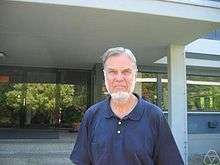Frans Oort
Frans Oort (born 17 July 1935) is a Dutch mathematician, specializing in algebraic geometry.
Frans Oort | |
|---|---|
 Frans Oort, Oberwolfach 2004 | |
| Born | 17 July 1935 |
| Nationality | Dutch |
| Alma mater | University of Leiden |
| Known for | André–Oort conjecture |
| Scientific career | |
| Fields | Mathematics |
| Doctoral advisors | Willem Titus van Est Jaap Murre |
Biography
Oort studied from 1952 to 1958 at Leiden University, where he graduated with a thesis on elliptic curves. He received his doctorate in 1961 in Leiden from Willem Titus van Est and Jaap Murre with thesis Reducible and Multiple Algebraic Curves,[1] but had previously studied under Jean-Pierre Serre in Paris and Aldo Andreotti in Pisa. Oort was from 1961 at the University of Amsterdam, where he became a professor in 1967. In 1977, until his retirement in 2000, he was a professor at Utrecht University.[2] He was a visiting scholar at several academic institutions, including Harvard University (1966/67) and Aarhus University (1972/73). In 2008 he was the Eilenberg Professor at Columbia University.
His research deals with, among other topics, abelian varieties and their modules. In 1994 he formulated what is now known as the André–Oort conjecture (generalizing a conjecture made in 1989 by Yves André).[3] In 2000 Oort proved a conjecture made by Grothendieck in 1970.[4] Oort was a co-author of an article on Poncelet's closure theorem[5] and the author of An aspect of harmony in music of Johann Sebastian Bach.
In 1962 Oort was an Invited Speaker with talk Multiple algebraic curves at the International Congress of Mathematicians in Stockholm. In 2011 he was elected a member of Academia Europaea.[2] In July 2013 he gave a talk at the International Congress of Chinese Mathematicians in Tapei.[6]
His doctoral students include Michiel Hazewinkel, Aise Johan de Jong, Hendrik Lenstra and Joseph Steenbrink.[1]
He was married to (and is now divorced from) author Marijke Harberts, who wrote Afschied van Joke Smit (1987 biography of Joke Smit), Doezamand: Roman (1994 novel based upon her life as a student), and Eerlijk gezegd: Interviews met vrouwen (1974 collection of interviews with women); the couple have three grown sons, among whom is the Ultimate Frisbee player Jeroen Oort.
Selected publications
- Commutative group schemes, Springer 1966; Oort, F (2006). pbk reprint. ISBN 9783540371717.
- as editor: Algebraic Geometry, Oslo 1970, Wolters-Noordhoff 1972
- with Ke-Zheng Li: Moduli of supersingular abelian varieties, Springer 1998
- as editor with Steenbrink and van der Geer: Arithmetic algebraic geometry , Birkhäuser 1991; g, van der Geer; Oort, F; Steenbrink, J.H.M (2012-12-06). pbk reprint 2012. ISBN 9781461204572.
- as editor with Carel Faber and Gerard van der Geer: Moduli of abelian varieties, Birkhäuser 2001
- L. Schneps, ed. (2014). "Did earlier thoughts inspire Grothendieck? by Frans Oort". In: Alexander Grothendieck: A mathematical portrait. Sommerville, Massachusetts: International Press. pp. 231–268. S2CID 17286534.
- with Ching-Li Chai: Chai, Ching-Li; Oort, Frans (2017). "Life and work of Alexander Grothendieck". ICCM Notices. 5: 22–50. doi:10.4310/iccm.2017.v5.n1.a2. S2CID 34440499.
References
- Frans Oort at the Mathematics Genealogy Project
- "Frans Oort". Academia Europaea.
- Zannier, Umberto (2012). Some problems of unlikely intersections in arithmetic and geometry. Princeton University Press. p. 9. ISBN 9780691153711.
- Oort, Frans (2000). "Newton polygons and formal groups: Conjectures by Manin and Grothendieck". Ann. of Math. Series 2. 152 (1): 183–206. arXiv:math/0007201. doi:10.2307/2661381. JSTOR 2661381.
- Bos, Henk JM; Kers, Cees; Oort, Frans (1984). Poncelet's closure theorem, its history, its modern formulation, a comparison of its modern proof with those by Poncelet and Jacobi, and some mathematical remarks inspired by these early proofs. Rijksuniversiteit Utrecht. Mathematics Instituut.
- Oort, Frans (November 2013). "Prime numbers" (PDF). Notices of the International Congress of Chinese Mathematicians. 1 (2): 60–78. doi:10.4310/iccm.2013.v1.n2.a8.
External links
- Homepage in Utrecht
- "Frans Oort on "John Tate receives the 2010 Abel Prize"". YouTube. 23 January 2016.